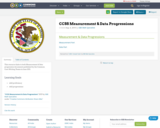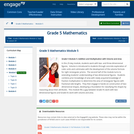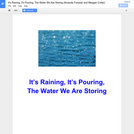
This resource links to both Measurement & Data progression documents published by the Common Core Writing Teams in June 2011.
- Material Type:
- Assessment
- Homework/Assignment
- Teaching/Learning Strategy
- Date Added:
- 05/09/2013

This resource links to both Measurement & Data progression documents published by the Common Core Writing Teams in June 2011.

In this 25-day module, students work with two- and three-dimensional figures. Volume is introduced to students through concrete exploration of cubic units and culminates with the development of the volume formula for right rectangular prisms. The second half of the module turns to extending students understanding of two-dimensional figures. Students combine prior knowledge of area with newly acquired knowledge of fraction multiplication to determine the area of rectangular figures with fractional side lengths. They then engage in hands-on construction of two-dimensional shapes, developing a foundation for classifying the shapes by reasoning about their attributes. This module fills a gap between Grade 4s work with two-dimensional figures and Grade 6s work with volume and area.
Find the rest of the EngageNY Mathematics resources at https://archive.org/details/engageny-mathematics.

Our students will be studying and exploring the human impact on groundwater. They will study the water deprivation impacts both locally and in the San Joaquin Valley. Students will explore and come to understand the benefits of collecting rainwater. We partnered with the City of Eugene and had the wonderful Jackie come in. Our students brought in many of the materials including cardboard boxes, empty plastic containers (sour cream, water bottles,etc), tin foil, wax paper, duct tape,etc. We as teachers provided the underground sprinkler tubing cutting material, more tape and supplies. We tested this project with our 5th graders so we could make improvements and continue this project next year. In order to complete this project, we needed a full three weeks of working for an hour plus every day. We incorporated this project into our reading and science timeline.

(Nota: Esta es una traducción de un recurso educativo abierto creado por el Departamento de Educación del Estado de Nueva York (NYSED) como parte del proyecto "EngageNY" en 2013. Aunque el recurso real fue traducido por personas, la siguiente descripción se tradujo del inglés original usando Google Translate para ayudar a los usuarios potenciales a decidir si se adapta a sus necesidades y puede contener errores gramaticales o lingüísticos. La descripción original en inglés también se proporciona a continuación.)
En este módulo de 25 días, los estudiantes trabajan con figuras dos y tridimensionales. El volumen se introduce a los estudiantes a través de la exploración concreta de unidades cúbicas y culmina con el desarrollo de la fórmula de volumen para los prismas rectangulares correctos. La segunda mitad del módulo se convierte en extender a los estudiantes la comprensión de las figuras bidimensionales. Los estudiantes combinan el conocimiento previo del área con el conocimiento recién adquirido de la multiplicación por fracción para determinar el área de las figuras rectangulares con longitudes laterales fraccionadas. Luego participan en la construcción práctica de formas bidimensionales, desarrollando una base para clasificar las formas razonando sobre sus atributos. Este módulo llena un vacío entre el trabajo de Grado 4 S con figuras bidimensionales y el trabajo de grado 6 con volumen y área.
Encuentre el resto de los recursos matemáticos de Engageny en https://archive.org/details/engageny-mathematics.
English Description:
In this 25-day module, students work with two- and three-dimensional figures. Volume is introduced to students through concrete exploration of cubic units and culminates with the development of the volume formula for right rectangular prisms. The second half of the module turns to extending students understanding of two-dimensional figures. Students combine prior knowledge of area with newly acquired knowledge of fraction multiplication to determine the area of rectangular figures with fractional side lengths. They then engage in hands-on construction of two-dimensional shapes, developing a foundation for classifying the shapes by reasoning about their attributes. This module fills a gap between Grade 4s work with two-dimensional figures and Grade 6s work with volume and area.
Find the rest of the EngageNY Mathematics resources at https://archive.org/details/engageny-mathematics.
![OREGON MATH STANDARDS (2021): [5.GM]](https://img.oercommons.org/160x134/oercommons/media/courseware/lesson/image/13138_ODE_Math_Logo_2018-H_color_BvjqVNy.png)
The intent of clarifying statements is to provide additional guidance for educators to communicate the intent of the standard to support the future development of curricular resources and assessments aligned to the 2021 math standards. Clarifying statements can be in the form of succinct sentences or paragraphs that attend to one of four types of clarifications: (1) Student Experiences; (2) Examples; (3) Boundaries; and (4) Connection to Math Practices.